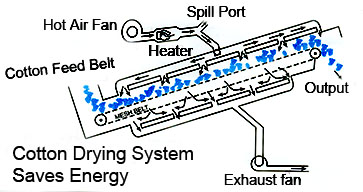Cotton Drying System Saves Energy
Len Alphin, co-owner of Commonwealth Gin of Windsor, Virginia, says his new ARS designed conveyor-belt dryer handled cotton so sopping wet it was impossible to dry in the conventional tower dryer at another gin he owns. Tower dryers use hot air to blow cotton pneumatically through a series of racks.
Weldon Laird, an ARS agricultural engineer at Lubbock, Texas, designed the belt dryer, along with colleague Roy V. Baker and others. He says, "The belt dryer had no trouble drying the cotton because the belt moves slowly enough to let the cotton stay in the heated air for up to 90 seconds or longer—instead of the 6 to 12 it has when blowing through a conventional tower dryer at high air pressure.
"This machine not only takes the time needed to do the job, but it saves money and often does a better job of preserving cotton fiber quality," says Laird. "The temperature is about half, the horsepower's a fraction that of a tower dryer's, and the air pressure is 100 times lower—adding up to energy savings. It pays for itself in 1 to 5 years, depending on a gin's yearly production," he says.
 Graphic - Cotton Drying System |
Laird's dryer carries cotton piled in an even layer on a wire mesh belt that is 6 feet wide by 40 to 70 feet long. Hot air is forced downward through the cotton and the belt.
Currently, two gins in Texas use the belt, as well as the Virginia gin. "One Texas gin has dried 354,000 bales of cotton with the belt over the past 5 years," says Laird. "The Terry County Co-op Gin of Brownfield, Texas, found that when they first got the dryer it conditioned very wet cotton so well that only 11 percent was classed below grade, compared to 100% of a similar batch that was dried before the belt dryer was installed."
Managers of a kenaf-processing plant in Mississippi also turned to Laird and his belt dryer for help when they faced a backlog of 3 crop years worth of kenaf to dry. Kenaf is a bamboo-like relative of cotton used to make a variety of products, including textiles and paper.
From 1985 to 1990, Laird worked on building and testing a prototype dryer and operating system at the Lubbock lab. Then the Chickasha Cotton Oil Company of Casa Grande, Arizona, joined about a dozen state and national cotton organizations in a cooperative field demonstration to determine the system’s efficacy.
Laird is now working on a new application with Cotton Incorporated of Raleigh, North Carolina: to dry cottonseed coated with a wet cornstarch solution to create a flowable product for cattle feed. The Chickasha Company plans to test it in one of their plants in Georgia.
ARS research has shown cottonseed to be a nutritious cattle feed. But cottonseed has failed to move into widespread use because it has sticky fibers that cause it to clump together and jam feed-processing equipment. By coating the seeds and then using the conveyer belt to dry the coating, Laird and his colleagues produce seed as hard as corn or other grain feeds.
"Unlike for cottonseed oil, where there's a glut, there's a big market for cottonseed feed that we can open up if this works," says Laird. -- By Don Comis, ARS.
USDA-ARS Cropping Systems Research Laboratory, Box 215, Lubbock, TX 79401; phone (806) 746-5353.






